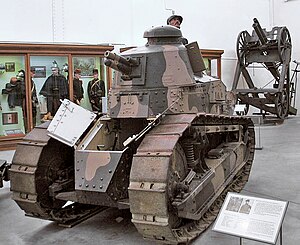Renault FT-17
| Renault FT | |
|---|---|

FT with Girod turret at Royal Museum of the Armed Forces, Belgium.
|
|
| Type | Light tank |
| Place of origin | France |
| Service history | |
| In service | 1917–1949 |
| Used by |
|
| Wars |
|
| Production history | |
| Designed | 1916 |
| Variants |
|
| Specifications | |
| Weight | 6.5 tonnes (6.4 long tons; 7.2 short tons) |
| Length | 5.00 m (16 ft 5 in) |
| Width | 1.74 m (5 ft 9 in) |
| Height | 2.14 m (7 ft 0 in) |
| Crew | 2 (commander, driver) |
|
|
|
| Armor | 8 to 22 mm (0.31 to 0.87 in) |
|
Main
armament |
Puteaux SA 1918 37 mm gun or 8 mm Hotchkiss machine gun |
| Engine | Renault 4-cyl, 4.5 litre, thermo-siphon water-cooled; Gasoline (petrol) pump; Engine oil pump; Zenith preset carburettor; Magneto ignition |
| Power/weight | 5 hp/tonne |
| Transmission | sliding gear; four speeds reverse, one forward. One main clutch plus two subsidiary clutches (one for each of the two tracks) used for steering the tank. |
| Suspension | vertical springs |
| Fuel capacity | 95 litres (about 8 hours) |
|
Operational
range |
60 km (37 mi) |
The Renault FT, frequently referred to in post-World War I literature as the "FT-17" or "FT17", was a French light tank that was among the most revolutionary and influential tank designs in history. The FT was the first production tank to have its armament within a fully rotating turret. The Renault FT's configuration – crew compartment at the front, engine compartment at the back, and main armament in a revolving turret – became and remains the standard tank layout. As such, historians of armoured warfare have called the Renault FT the world's first modern tank.
Over 3,000 Renault FT tanks were manufactured by French industry, most of them during the year 1918. Another 950 of an almost identical licensed copy of the FT (the M1917) were made in the United States, but not in time to enter combat.
The FT was designed and produced by the Société des Automobiles Renault (Renault Automobile Company), one of France's major manufacturers of motor vehicles then and now.
It is thought possible that Louis Renault began working on the idea as early as 21 December 1915, after a visit from Colonel J.B.E. Estienne. Estienne had drawn up plans for a tracked armoured vehicle based on the Holt caterpillar tractor, and, with permission from General Joffre, approached Renault as a possible manufacturer. Renault declined, saying that his company was operating at full capacity producing war materiel and that he had no experience of tracked vehicles. Estienne took his plans to the Schneider company, where they became France's first operational tank, the Schneider CA.
At a later, chance meeting with Renault on 16 July 1916, Estienne asked him to reconsider, which he did. The speed with which the project then progressed to the mock-up stage has led to the theory that Renault had been working on the idea for some time.
Louis Renault himself conceived the new tank's overall design and set its basic specifications. He imposed a realistic limit to the FT's projected weight, which could not exceed 7 tons. Louis Renault was unconvinced that a sufficient power-to-weight ratio could be achieved with the production engines available at the time to give sufficient mobility to the heavy tank types requested by the military. Renault's most talented industrial designer, Rodolphe Ernst-Metzmaier, generated the FT's detailed execution plans. Charles-Edmond Serre, a long time associate of Louis Renault, organized and supervised the new tank's mass production. The FT's tracks were kept automatically under tension to prevent derailments, while a rounded tail piece facilitated the crossing of trenches. Because the engine had been designed to function normally under any slant, very steep slopes could be negotiated by the Renault FT without loss of power. Effective internal ventilation was provided by the engine's radiator fan, which drew its air through the front crew compartment of the tank and forced it out through the rear engine's compartment.
...
Wikipedia
